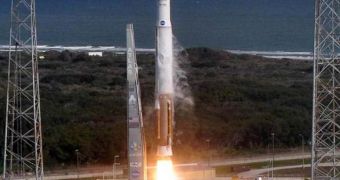It's no longer a secret to anyone that the American space agency plans to send a new orbiter spacecraft to Mars by the end of 2013. In a recent announcement, NASA informed that it has selected the delivery system that will get the spacecraft to the Red Planet.
The Mars Atmosphere and Volatile Evolution (MAVEN) orbiter will have a fairly straightforward and complex task once it reaches the planet, and namely determine what happened to its atmosphere in the past.
It's mission is basically to make sense of the ancient climate that existed on our neighboring planet, given that readings obtained from other rovers, landers and orbiters are contradictory at times.
NASA now says that it will use an Atlas 5 delivery system to get MAVEN off the ground In November 2013. These rockers have an excellent track history, and were recently used to launch the Solar Dynamics Observatory (SDO) mission to orbit.
These rockets are built by United Launch Alliance (ULA), which is a joint venture of Lockheed Martin and the Boeing Company, and launched from the Cape Canaveral Air Force Station, in Florida.
For the MAVEN mission, the Atlas 5 will be used in its basic form, without any solid rocket boosters (SRB) like the shuttles use to get to low-Earth orbit.
The delivery system will feature a single-engine Centaur upper stage, as well as 4-meter payload shroud that will protect the $438 million spacecraft during lift-off.
MAVEN is heavily based on the same basic bus that was used to create the Mars Reconnaissance Orbiter (MRO) spacecraft, officials at NASA say. However, it is a stripped down version of the orbiter.
The spacecraft will reach its intended destination sometime in the autumn of 2014, the current plans show. MAVEN will be placed on an elliptical orbit 90 to 3.870 miles (145 to 6228 kilometers) above Mars' surface. Geologists say that the planet once had a more dense atmosphere, which allowed the presence of liquid water on its surface, but dramatic climate changes led to huge losses of the stuff.
MAVEN will get as close as 80 miles (128 kilometers) to the Martian surface in order to draw samples from the atmosphere, and measurements of the current state of the gas shroud will provide hints on the history of climate change.
Images collected by the HiRISE instrument on the Mars Reconnaissance Orbiter (MRO) have revealed the existence of what appear to be dry riverbeds and deltas on the planet.
The rovers Spirit and Opportunity have found minerals that could have only formed in the presence of water, and the Phoenix Mars Lander detected water ice near the North Pole.
This is where MAVEN comes in. Its suite of scientific instruments will be perfectly calibrated to conduct measurements of the atmosphere, and to determine the cause of the ancient loss, Space reports.

 14 DAY TRIAL //
14 DAY TRIAL //